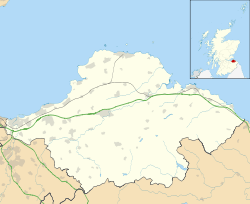Humbie
Coordinates: 55°51′14″N 2°52′01″W / 55.854°N 2.867°W
Humbie is a hamlet and rural parish in East Lothian, Scotland. It lies in the south-west of the county, approximately 10 miles south-west of Haddington and 15 miles south-east of Edinburgh. Humbie as we know it today was formed as the result of the union between Keith Marischal and Keith Hundeby in 1618.
Origins
Originally, Humbie formed part of the Barony of Keith, and was anciently known as Keith Hundeby. The lands were held by Simon Fraser of Keith in the reign of David I. A charter signed by Fraser in 1191 is said to be the first mention of the Anglo-Norman Frasers and the Barony in extant records. Keith Marischal House stands a mile to the NNW of Humbie, and was the caput of the ancient barony. It is a long house with a vaulted ground floor, built in 1589 by the Keiths, who were then Grand Marischals of Scotland. The north front was baronialized in 1889 by Kinnear & Peddie. Interior decorations and fireplaces were done circa 1740, 1800, 1820, and 1869.
Later proprietors
Possibly the most prominent proprietors of Humbie proper were a cadet branch of the Hepburn of Waughton & Luffness family, the Hepburns of Kirklandhill. Alexander Nisbet states that Adam Hepburn of Kirklandhill purchased Humbie and Hartside from James Lawson of Humbie in 1586. He married Agnes, daughter to Henry Foulis of Colinton and his spouse Margaret, a daughter of James Haldane of Gleneagles. His son and successor was Sir Adam Hepburn of Humbie, one of the Senators of the College of Justice, who married in 1629 Agnes, daughter to George Foulis of Ravelston, Master of the Mint. Of his children, Sir Adam's daughter Jean married John Cockburn of Ormiston, and they were parents of Adam Cockburn of Ormiston, Lord Justice Clerk.
Humbie House lies about half a mile north-east of the church. It was built during the late 18th century, replacing an earlier house, with substantial alterations in the 19th century.
Church
The "T-Plan" Parish Church was rebuilt in 1800 and Gothicized in 1866 by David Bryce. The 'chancel' was added in 1932. Memorials in the churchyard include a heraldic tablet of the Borthwicks of Whitburgh of the early 17th century, and another monument to James Scriven of Ploughlandhill who died in 1668.
Humbie Heinkel
On 28 October 1939, a Heinkel He 111H Luftwaffe bomber from Kampfgeschwader 26 was the first German aircraft to be shot down on British soil by the RAF. As it returned from a reconnaissance over the Firth of Clyde, Supermarine Spitfire fighters of 602 and 603 Squadron intercepted the bomber over Inchkeith and it crash landed near Humbie.[1] It is often referred to as the 'Humbie Heinkel', and Archie McKellar was credited with the victory.[2]
Notable Persons
- Sir Robert Dundas of Beechwood, baronet, FRSE (1761-1835) was born in the manse at Humbie.
References
- ↑ "Welcome to the RAF Drem Website". Welcome to the RAF Drem Website. 22 October 1939. Retrieved 17 November 2015.
- ↑ "602 Squadron Museum Association". 602 Squadron Museum Association. 17 July 1944. Retrieved 17 November 2015.
- The Buildings of Scotland - Lothian (except Edinburgh), by Colin McWilliam, London, 1978, pps: 258-9, and 269. ISBN 0-14-071066-3
- grid reference NT458627
External links
| Wikimedia Commons has media related to Humbie. |
- Undiscovered Scotland - Humbie Kirk
- Education Scotland - Humbie Heinkel
- FamilySearch - Humbie, East Lothian, Scotland


